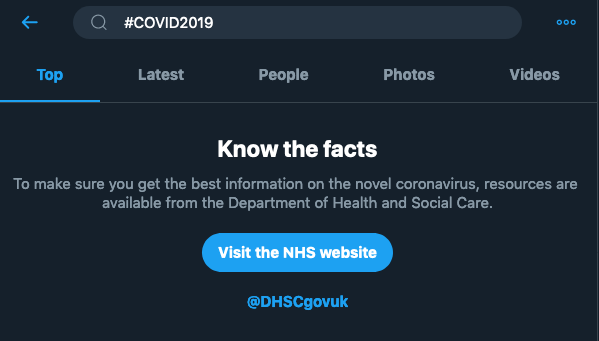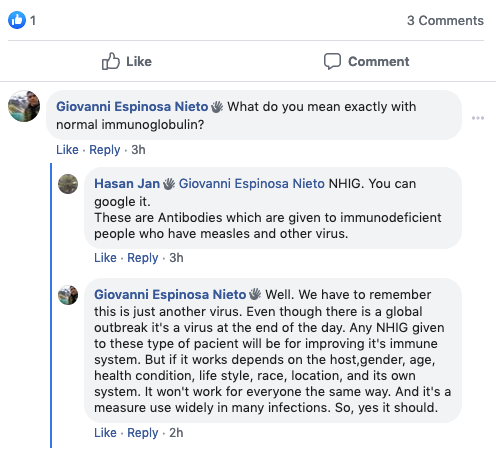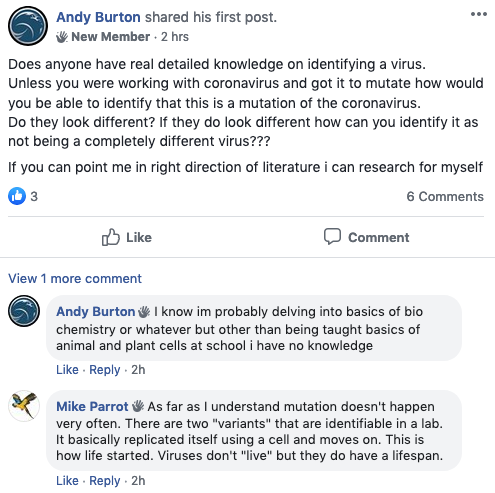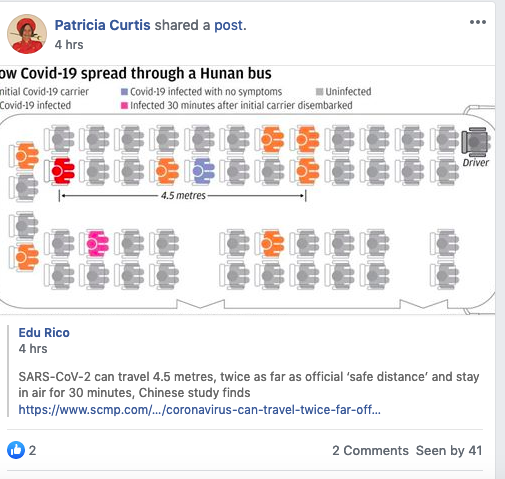The Corona Virus outbreak is an ongoing global outbreak of Corona Virus disease (COVID-19) caused by the SARS Corona Virus 2 (SARS-CoV-2). The outbreak was first identified in Wuhan, Hubei, China in December 2019, and has since been declared a Public Health Emergency of International Concern by the World Health Organization. As of 10 March 2020, over 116,000 cases have been confirmed globally, of which 5,800 were classified as serious. More than 115 countries and territories have been affected, with major outbreaks in central China, Italy, South Korea and Iran. More than 4,100 people have died: more than 3,100 in mainland China and around 960 in other countries. More than 64,000 people have recovered.
The virus spreads between people in a similar way to influenza, via respiratory droplets from coughing or sneezing. The time between exposure and symptom onset is typically five days, but may range from two to fourteen days. Symptoms are most often fever, cough, and shortness of breath. Complications may include pneumonia and acute respiratory distress syndrome. There is currently no vaccine or specific antiviral treatment, but research is ongoing. Efforts are aimed at managing symptoms and supportive therapy. Recommended preventive measures include hand-washing, maintaining distance from other people (particularly those who are sick) and monitoring and self-isolation for fourteen days for people who suspect they are infected.
Public health responses around the world have included travel restrictions, quarantines, curfews, and school closures. They have included the quarantine of Hubei, China, and the entirety of Italy; various curfew measures in China and South Korea; screening methods at airports and train stations; and travel advisories regarding regions with community transmission. Schools have closed nationwide or locally in some countries, affecting more than 300 million students.
The wider impact of the outbreak has included social and economic instability, xenophobia and racism against people of Chinese and East Asian descent, and the online spread of misinformation about the virus.
This is where Social Media comes in to play. As possibly everyone these days, I have been following this issue from my house, and from my laptop. In the past coupe of days I decide to do my own little research and here are some preliminary observations about what’s happening on social media, how are we doing risk communication and what could be done better.
First, a disclaimer is due: I have used a very small sample for this research, about 50 Facebook pages and groups and around 50 twitter accounts. I have only looked at content in English and Italian, so the sample is even more limited. Nonetheless, I think that the findings are interesting, and possibly someone would want to look into it!
The role of Social Media companies
Both Twitter and Facebook have stepped up their game and both platforms are re-directing users that look for any of the related hashtags to the local authorities pages.
Interesting enough, on Facebook the banner disappears when you go from the search home (all) to another section, for example if you look for groups the banner is not there. This is actually something that could (and should) be changed, since the majority of rumors and information about the virus is spread via FB groups.

Nonetheless, this is a very good improvement, and also the result of the increasing pressure on social media companies to handle rumors and misinformation better on their platforms.
Engagement: maybe not…
The WHO Facebook page is well done: clear and visual information are provided, interviews and a ton of multimedia content. Unfortunately the content is only and exclusively available in English. Even if we assume that most people know English, which we know not to be true, the World Health Organization should have all of its content translated, especially in a global pandemic like this one.
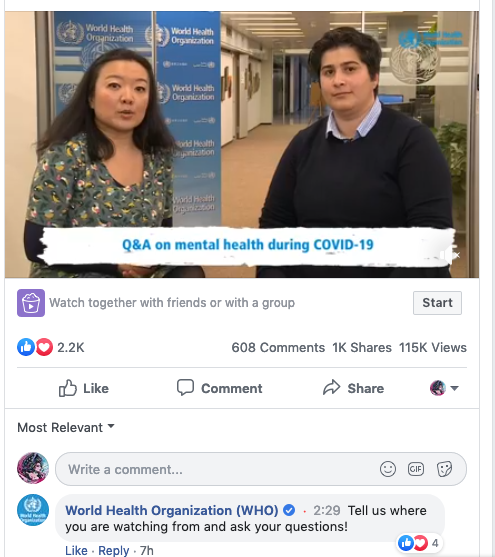
In several live videos people are asked to submit questions that are then answered live. In some of these videos there are around 500 messages posted and it is clear that there is no capacity to handle that – almost 90% of messages have no-reply and a large number of the messages is insulting or totally irrelevant but still left there. The same happens on the WHO You Tube channel where all of the live interviews about Covid-19 are published: an incredible amount of comments, no responses from the authorities themselves.
People are trusting health and government authorities less and less, and they try to find their own solutions in lack of trusted ones.
Similarly, on the Italian Ministry of Health page on Facebook, there is almost no message that has a reply, whilst posts collect something like 200 comments each.
NHS, which has very few interactions on their page, also does not interact nor responds, as does CDC, with almost 1000 comments per post, none of which moderated or responded to.
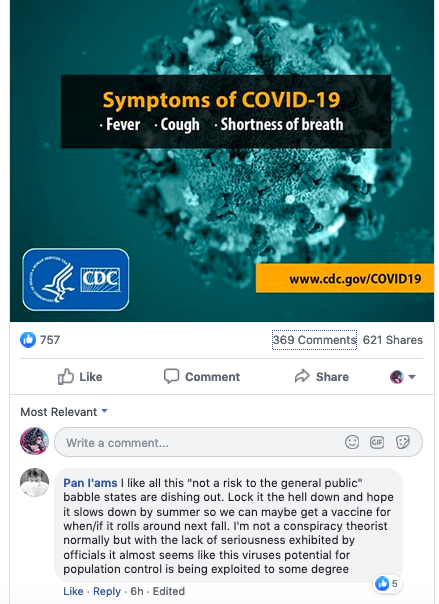
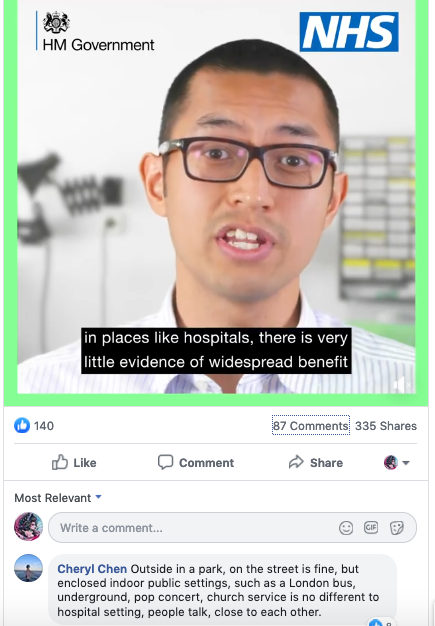
Twitter is also used mainly as a publishing tool: no organization engages with its audience and questions, rumors and opinions are thrown out there but fall into a hole of deep silence.
The over-production of information when there is no information
One of the things I noticed frustrates people, it is to accept that this new disease has no “solution”. We are so used to have a “pill for everything” that it is really hard to accept that: 1) there is little you can do not to be infected, and rather than interact as little as possible with others, that’s it; 2) there is little to do if you get it, because there is no vaccine or cure.
In short: there is little more to say about Covid-19 because it is a new virus so it is being studied as we speak. The audience is left with following the numbers and do what authorities are suggesting, which is not much, except to limit movement and wash your hands.
Some of the most common comments under the WHO posts on You Tube, for example, is that people complaint that they know already what the video says, and they want “other” information.

This is paired with the creation of numerous Facebook pages and Twitter accounts that all claim to provide “up to date” and “new” information on the Virus.
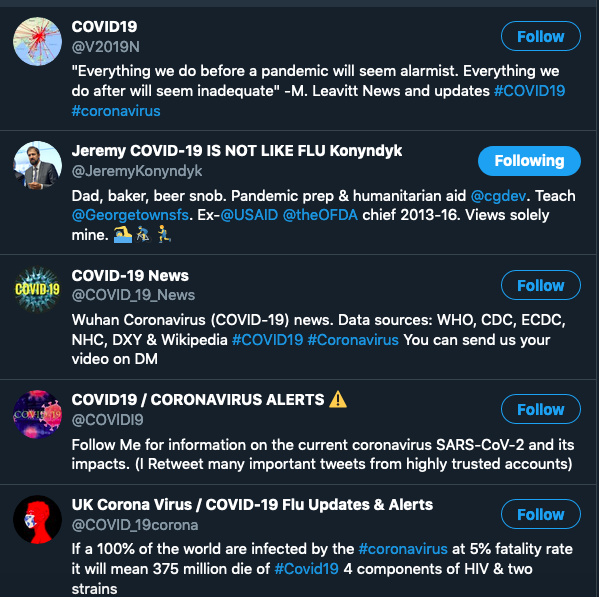
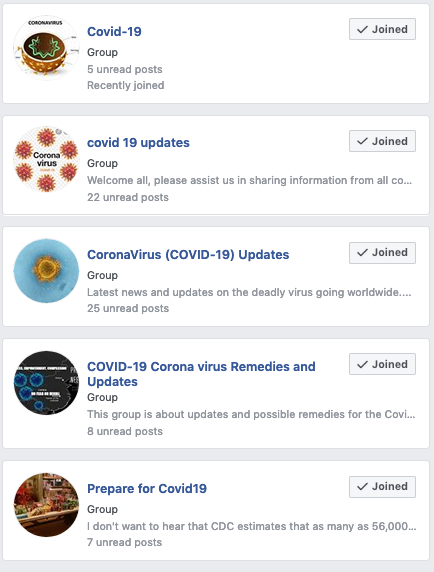
These accounts and pages have some, or all, of the following characteristics in common:
- absence of the actual credentials of the page/accounts managers;
- absence of any link to a website or online page;
- posts are often re-posts of other sources;
- claim to only post “confirmed information”.
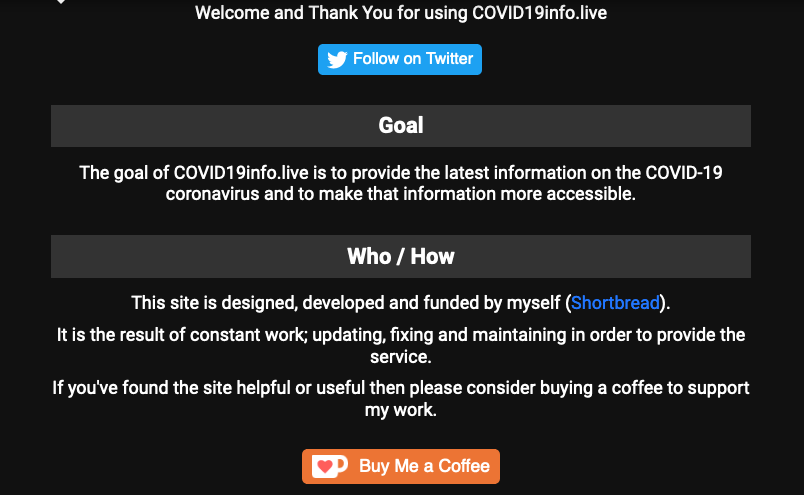
The majority of these groups re-post a mix of media articles about the spread of the virus, official information from verified accounts like CDC, or the NHS. These pages though become very interesting when we look at the comments below, where people try to understand and ask questions and other people try to respond. Often, these pages are set up by housewives, IT, teachers, former nurses, retired people, students, simply to try to make sense of the overload of information, often contrasting, that populate the Internet.
Authorities not engaging in the conversation seems to be resulting in more rumors and more misinformation being circulated, with “normal” people setting up systems to support each other, to fill the void left.
Often the responder is not a doctor or a professional, but simply someone that knows or think he/she knows the answer. Sometimes people just attempt to answer or simply try to “ease” a stressed/worried person on the other side. Sometimes dodgy answers and sources are posted from “retired” doctors, nurses, anonymous “confirmed” sources, etc.
If I have to try to answer to the question of why people create and use these groups, rather than use the already existing official sources that have verified content, I would say that the reason may be two:
- Nobody answers people’s concerns on the official channels;
- Somehow people do not trust that the official channels are providing them with all the information they need.
The real conversation, where people get the information they seek (true or not), and discuss issues that concern them, is happening in the comments sections of the official and unofficial social media channels
The increased use of closed networks
Some year ago I wrote about the use of closed networks for exchanging information in unstable settings, like civil wars or conflicts. In that specific case, I mentioned that increasingly communities use closed networks, for example WhatsApp messages, closed Facebook groups or pages, etc. to exchange information based on peer to peer trust – I trust you and therefore I trust what you are telling me – which allows for the primary source to become irrelevant to the reliability of the information, because the trust is transferred to the sender.
In the Covid-19 case I have noticed an increase in the use of closed networks.
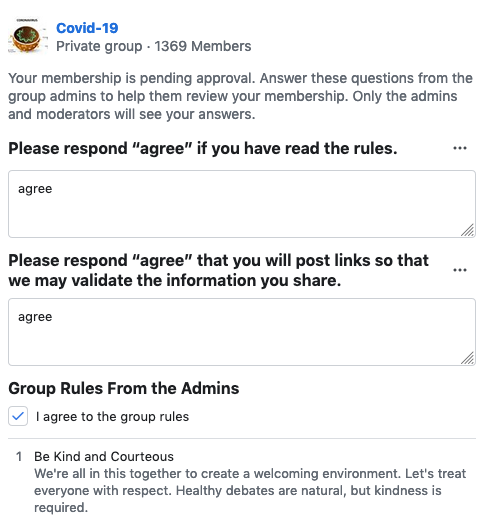
A really high amount of Facebook groups about the virus are set on private and require you to “apply” to entry. The majority of these groups have Group Rules to have to abide to (yeah!!) but very few of them have as a rule to only post truthful content with sources (meah).
Messages exchanged on closed networks are increasing fear and panic, and erode trust, but the reality is that most people have good intentions and are genuinely worried
The audio below has been circulating on WhatsApp in Italy. It is in Italian of course. The video has been sent from person to person, claiming it comes from a ” doctor from San Gerardo” – no other information attached. In the audio file you hear a man that talks in a very agitated way, using often technical medical terms, about the gravity of the situation claiming that doctors are being kept silent, but that the situation is much worst than depicted by the media and the government.
Both the means above are closed networks where the information is less visible; shared intentionally with a trusted group; does not require real vetting, because it relies on the trust of the person that sends it to you, not on the trust of the unknown primary source. This makes the rumors and misinformation circulating on these networks much more difficult to catch and debunk. They allow for the information to spread fast because it is free and relies on homophily; both the closed FB groups and the WhatsApp systems are relatively totally free and they prevent any sort of cross-verification from happening. Only people that are inclined to trust the information will receive it, and they only share it with others that have their same values, so the likelihood of someone within the system to doubt the information declines considerably.
Hate speech and xenophobia
The most scary part of the conversations happening on social media, and very often on the official social media pages of authorities like WHO, NHS, CDC, etc., is that the lack of moderation translates into these pages becoming a platform for racist and xenophobic statements and conversations, with rumors fueling stereotypes, fueling hate.


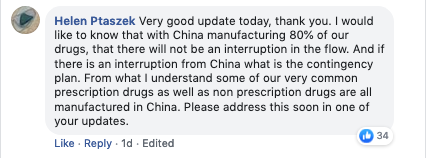
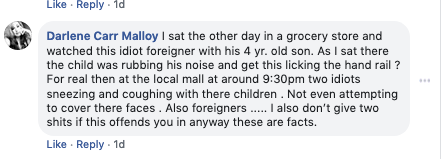
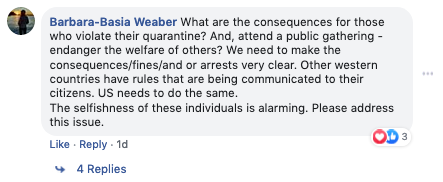
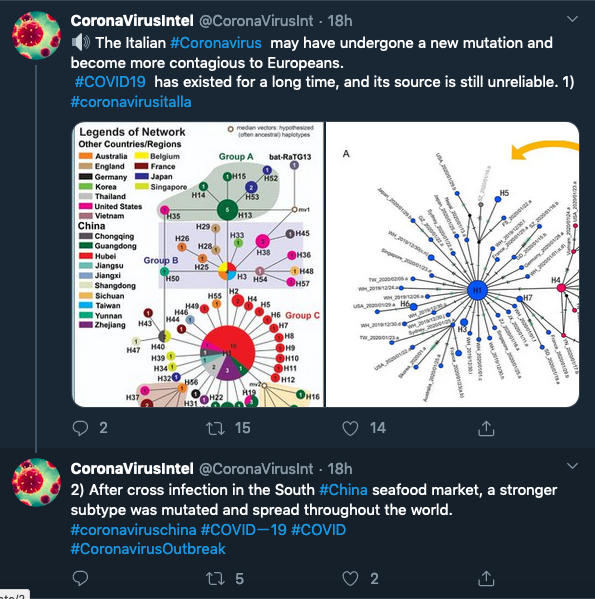
In none of these cases there was any attempts to intervene in the conversation (I am not suggesting to remove these comments, as frankly I don’t think it would help).
Additionally, it has to be noted that in some countries, like Italy and the USA, there seems to be a growing rhetoric that calls for the removal of constitutional rights, like the right to free movement and work. Personally, this can be perceived as an underestimation of the role of these liberties in people’s well-being (physical and psychological) and the actual relative advantage that this can bring on stopping the disease. The polarization of the conversation in between “We are going to die” and “It is just a flu” is also spilling over to what is acceptable (and efficient) in contrasting the spread of COVID-19 and its political and social implications.
The secret to people complying with governmental rules like forced quarantine does not lie in the ability to enforce it, but in the existence of a trusting relationship in between health authorities and governments and its citizens, whereby both are perceived as partners in the same fight.
Questions?
The following questions that have been gravitating in my head while looking at the issues explained above, and I would love for people that have any answers to let me know:
How difficult it is to build a gazetteer of frequently asked questions, by location and by language (on the model of this one) to be used as a bot for official social media accounts or as a simple interface for people, to use (literally a simple interface where I can type “Is there a vaccine for Covid?” and get a simple answer with sources;
Why not use the energy and time (since we are all quarantined) of good willing people, that are right now privately managing increasing amount of random pages on the virus, to work together with responders to provide answers to users on social media (very much like what the Standby Task Force could do, with some training from Build Peace for example, supported by an algorithm, that using AI could provide more and up to date information on the virus as they come out);
On the same line above, why not engaging young tech savvy people to create a real-time rumors debunking service? I keep thinking that it must be possible to link the technology we have with the amount of men-power available online to create a semi-automated system to debunk rumors as they arise (something like this). Ideas? Suggestions?
